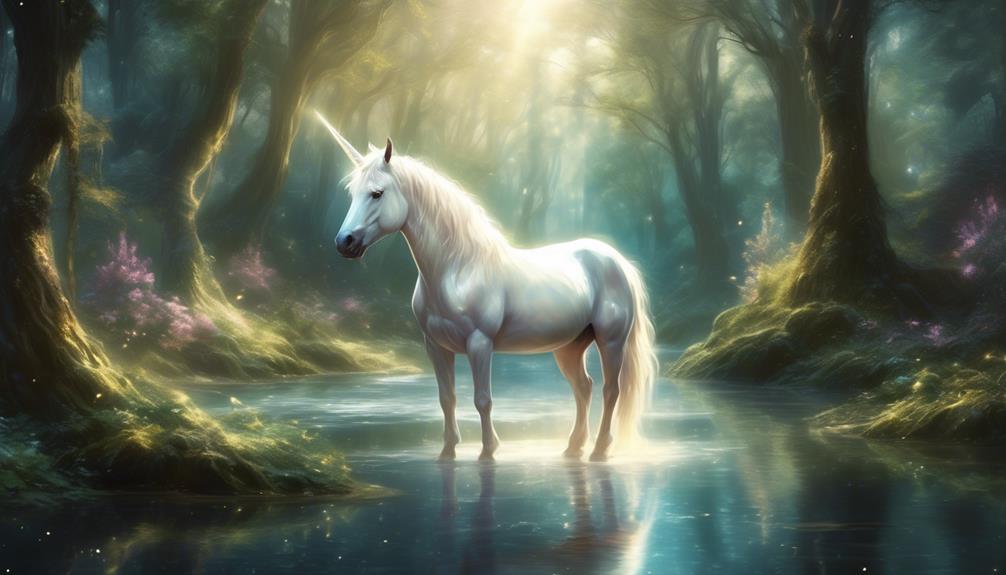The discovery of fossilized remains of the Siberian unicorn, Elasmotherium sibiricum, in Kazakhstan has rekindled the age-old debate about the existence of unicorns. These majestic creatures, often depicted in mythology and folklore, have captured the imagination of people for centuries.
However, the recent findings have prompted scientists to reevaluate their understanding of these enigmatic beings. The implications of these discoveries are far-reaching, challenging conventional beliefs about the timeline of unicorn extinction and prompting a closer examination of historical accounts and cultural significance.
Myth and Reality: Uncovering Ancient Accounts
Unearthing ancient accounts sheds light on the enduring myth of unicorns and their fascinating intersection with reality.
The recent discovery of unicorn fossils in Kazakhstan challenges the perception of these creatures as purely mythical. Known as Elasmotherium sibiricum, these creatures roamed the earth approximately 29,000 years ago. Contrary to popular depictions, they resembled more of a rhinoceros than the commonly imagined horse-like creatures.
These Siberian unicorns stood about six feet tall, measured 15 feet long, and weighed around 8,000 pounds, dispelling the myth of their smaller size. The south of Western Siberia served as their habitat, extending beyond mythological landscapes.
This discovery has shifted the focus onto the physical characteristics and existence of unicorns, dispelling supernatural traits often associated with them in folklore and TV shows. It's an intriguing blend of myth and reality.
Unraveling the Horned Mystery: Historical Evidence
The historical evidence surrounding the existence of unicorns has been brought to light through the discovery of unicorn fossils in Kazakhstan, challenging previous beliefs and altering the timeline of their existence.
The discovery of the skull fossil of the Siberian unicorn, Elasmotherium sibiricum, has proven the existence of unicorns approximately 29,000 years ago, contrary to the previous belief that they went extinct 350,000 years ago.
This finding sheds new light on the true physical attributes of unicorns, revealing that they closely resembled rhinoceros rather than the traditional horse-like depictions.
Additionally, the unicorn's habitat in South Western Siberia challenges previous assumptions, showing that it wasn't limited to mythological landscapes as previously assumed.
This discovery has significantly expanded our knowledge of the real appearance, size, and habitat of unicorns, dispelling myths and misconceptions.
The Fossil Record: Clues to Unicorn Existence
The groundbreaking discovery of unicorn fossils in Kazakhstan has reshaped our understanding of the elusive creatures, shedding light on their true physical attributes and challenging long-held misconceptions about their existence.
For years, many believed unicorns were nothing more than mythical creatures, pretty horses with pearly white manes. However, researchers just definitively proved the existence of unicorns, known as Elasmotherium sibiricum, through the discovery of fossils in the south of Western Siberia.
These fossils serve as tangible evidence, providing insights into the unicorn's habitat, appearance, and evolutionary timeline. Contrary to popular belief, unicorns resembled rhinoceroses and lived approximately 29,000 years ago, weighing around 8,000 pounds and standing about six feet tall.
These findings debunked the magical portrayals of unicorns and emphasized the scientific evidence-based nature of their existence, challenging traditional folklore depictions.
Cultural Significance: Unicorns in Folklore
The cultural significance of unicorns in folklore transcends geographical boundaries and spans centuries, captivating the imagination and weaving into the tapestry of diverse mythologies and traditions.
The recent discovery of unicorn fossils in the Pavlodar region of Kazakhstan challenges traditional beliefs. Unlike the mystical fairytale creatures depicted in folklore, these unicorns were more akin to rhinoceroses, standing about six feet tall, measuring 15 feet long, and weighing around 8,000 pounds.
The study also revealed that the habitat of unicorns extended to the south of Western Siberia, challenging previous assumptions about their existence. This discovery adds a new layer to the cultural significance and fascination surrounding these creatures, prompting a re-evaluation of their place in folklore and challenging perceptions and understanding.
The comparison with the rest of the unicorn myths adds an intriguing dimension to their cultural significance.
Debunking Myths: Modern Scientific Perspectives
Challenging traditional beliefs, the recent discovery of unicorn fossils in Kazakhstan has prompted modern scientific perspectives to debunk myths surrounding the existence and characteristics of these enigmatic creatures.
The fossil, Elasmotherium sibiricum, found in the Pavlodar region of Kazakhstan, weighed around 8,000 pounds and measured approximately 15 feet long, making it one of the longest in comparison to modern-day rhinoceroses. This discovery challenges previous assumptions about the extinction of unicorns, as it suggests that they may have coexisted with humans.
Scientific studies have also refuted the myth of unicorns possessing magical flying abilities, emphasizing their physical characteristics and existence based on scientific evidence. Unicorns, often depicted as horses with pearly white coats, were found to resemble rhinos or woolly mammoths, challenging traditional perceptions and adding a new layer to their cultural significance.
Frequently Asked Questions
Did Unicorns Ever Exist?
Unicorn sightings and ancient depictions have fueled the debate about their existence. These mythological creatures have origins in folklore, but scientific evidence, historical accounts, and cultural significance contribute to the ongoing exploration of their reality.
Is Unicorn Real or Myth?
Ancient legends, modern sightings, and cultural significance all contribute to the enduring fascination with unicorn sightings. While no scientific evidence supports their existence, these mythical creatures continue to hold symbolic meaning as horned horses in various cultures.
Were Unicorns Hunted to Extinction?
Possible evidence, historical accounts, and unicorn symbolism fuel speculation about unicorn existence. Modern sightings and extinction theories challenge the idea of mythical creatures. Unicorn legends persist, but scientific evidence supports their real existence.
Are Unicorns or Mermaids Real?
Mythical creatures, folklore stories, and legend debates have long captured human imagination. Ancient beliefs in magical beings and mythological creatures continue to inspire cryptozoology speculation, adding depth to our understanding of cultural history and imagination.

